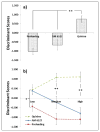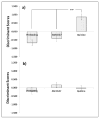CB1 antagonism produces behaviors more consistent with satiety than reduced reward value in food-maintained responding in rats
- PMID: 27005309
- PMCID: PMC5531753
- DOI: 10.1177/0269881116639287
CB1 antagonism produces behaviors more consistent with satiety than reduced reward value in food-maintained responding in rats
Abstract
Cannabinoid CB1 antagonists are widely known to reduce motivation for food, but it is not known whether they induce satiety or reduce reward value of food. It may therefore be necessary to compare effects of altered satiety and reward food value in the same appetitive task, and determine whether CB1 antagonism produces a behavior pattern similar to either, both, or neither. A fine-grained analysis of fixed-ratio 10 (FR10) responding for palatable food initially included number and duration of, and between, all lever presses and food tray entries in order to differentiate the pattern of suppression of prefeeding from that caused by reducing the reward value of the pellets with quinine. Discriminant function analysis then determined that these manipulations were best differentiated by effects on tray entries, pellet retrieval latencies, and time of the first response. At 0.5 mg/kg, AM 6527 produced similar effects to reducing reward value, but at 1.0 and 4.0 mg/kg, effects were more similar to those when animals were satiated. We conclude that AM 6527 both reduced reward value and enhanced satiety, but as dose increased, effects on satiety became much more prominent. These findings contribute to knowledge about the behavioral processes affected by CB1 antagonism.
Keywords: Cannabinoid; motivation; multivariate analysis; obesity; reward.
© The Author(s) 2016.
Conflict of interest statement
The authors declared no potential conflicts of interest with respect to the research, authorship, and/or publication of this article.
Figures




Similar articles
-
Cannabinoid CB1 antagonists and dopamine antagonists produce different effects on a task involving response allocation and effort-related choice in food-seeking behavior.Psychopharmacology (Berl). 2008 Mar;196(4):565-74. doi: 10.1007/s00213-007-0988-4. Epub 2007 Nov 15. Psychopharmacology (Berl). 2008. PMID: 18004546 Free PMC article.
-
The cannabinoid CB1 receptor inverse agonist AM 251 and antagonist AM 4113 produce similar effects on the behavioral satiety sequence in rats.Behav Brain Res. 2008 Nov 21;193(2):298-305. doi: 10.1016/j.bbr.2008.06.010. Epub 2008 Jun 17. Behav Brain Res. 2008. PMID: 18602425 Free PMC article.
-
AM 251 differentially effects food-maintained responding depending on food palatability.Pharmacol Biochem Behav. 2010 Jun;95(4):443-8. doi: 10.1016/j.pbb.2010.03.005. Epub 2010 Mar 21. Pharmacol Biochem Behav. 2010. PMID: 20331999
-
The cannabinoid CB1 antagonist AM 251 produces food avoidance and behaviors associated with nausea but does not impair feeding efficiency in rats.Psychopharmacology (Berl). 2005 Jul;180(2):286-93. doi: 10.1007/s00213-005-2171-0. Epub 2005 Mar 15. Psychopharmacology (Berl). 2005. PMID: 15948012
-
Cannabinoid CB1 receptor inverse agonists and neutral antagonists: effects on food intake, food-reinforced behavior and food aversions.Physiol Behav. 2007 Jul 24;91(4):383-8. doi: 10.1016/j.physbeh.2007.04.013. Epub 2007 Apr 14. Physiol Behav. 2007. PMID: 17521686 Free PMC article. Review.
Cited by
-
"Photo-Rimonabant": Synthesis and Biological Evaluation of Novel Photoswitchable Molecules Derived from Rimonabant Lead to a Highly Selective and Nanomolar "Cis-On" CB1R Antagonist.ACS Chem Neurosci. 2021 May 5;12(9):1632-1647. doi: 10.1021/acschemneuro.1c00086. Epub 2021 Apr 15. ACS Chem Neurosci. 2021. PMID: 33856764 Free PMC article.
-
Differential effects of cannabinoid CB1 inverse agonists and antagonists on impulsivity in male Sprague Dawley rats: identification of a possibly clinically relevant vulnerability involving the serotonin 5HT1A receptor.Psychopharmacology (Berl). 2017 Mar;234(6):1029-1043. doi: 10.1007/s00213-017-4548-2. Epub 2017 Feb 1. Psychopharmacology (Berl). 2017. PMID: 28144708
-
The Endocannabinoid System and Eating Behaviours: a Review of the Current State of the Evidence.Curr Nutr Rep. 2022 Dec;11(4):665-674. doi: 10.1007/s13668-022-00436-x. Epub 2022 Aug 18. Curr Nutr Rep. 2022. PMID: 35980538 Free PMC article. Review.
-
Hierarchical glucocorticoid-endocannabinoid interplay regulates the activation of the nucleus accumbens by insulin.Brain Res Bull. 2016 Jun;124:222-30. doi: 10.1016/j.brainresbull.2016.05.009. Epub 2016 May 18. Brain Res Bull. 2016. PMID: 27208730 Free PMC article.
-
Cannabimimetic phytochemicals in the diet - an evolutionary link to food selection and metabolic stress adaptation?Br J Pharmacol. 2017 Jun;174(11):1464-1483. doi: 10.1111/bph.13676. Epub 2017 Jan 16. Br J Pharmacol. 2017. PMID: 27891602 Free PMC article. Review.
References
-
- Ameloot K, Janssen P, Scarpellini E, et al. Endocannabinoid control of gastric sensorimotor function in man. Aliment Pharmacol Ther. 2010;31:1123–1131. - PubMed
-
- Bellocchio L, Lafenetre P, Cannich A, et al. Bimodal control of stimulated food intake by the endocannabinoid system. Nat Neurosci. 2010;13:281–283. - PubMed
-
- Brown RM, Seiden LS. Inter-response time changes as a function of water deprivation and amphetamine. J Pharmacol Exp Ther. 1975;193:701–712. - PubMed
-
- Cardinal P, Bellocchio L, Clark S, et al. Hypothalamic CB1 cannabinoid receptors regulate energy balance in mice. Endocrinology. 2012;153:4136–4143. - PubMed
MeSH terms
Substances
Grants and funding
LinkOut - more resources
Full Text Sources
Other Literature Sources

